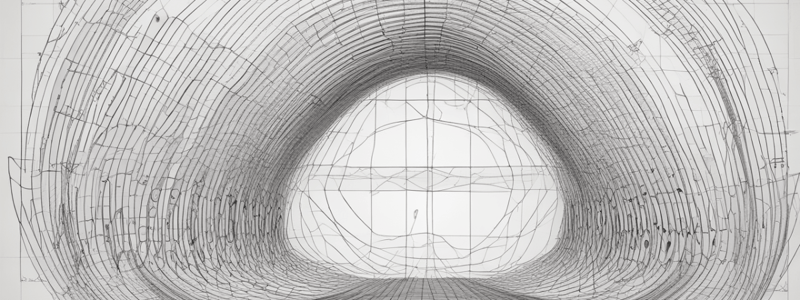Podcast
Questions and Answers
What is the range of the function when the coefficient of $x^2$ is negative?
What is the range of the function when the coefficient of $x^2$ is negative?
- All real numbers
- ($- ext{∞}; q]$ (correct)
- [q; $+ ext{∞}$)
- ($q; + ext{∞}$)
At which point does the turning point of the graph occur when $a > 0$?
At which point does the turning point of the graph occur when $a > 0$?
- (0, q) (correct)
- ($ ext{∞}$, $q$)
- (0, 0)
- (q, 0)
How can you find the y-intercept of the function $y = ax^2 + q$?
How can you find the y-intercept of the function $y = ax^2 + q$?
- By setting $y = 0$
- By setting $a = 0$
- By setting $x = 0$ (correct)
- By calculating the limit as $x$ approaches $ ext{∞}$
What does a positive value of $a$ indicate about the graph of the function?
What does a positive value of $a$ indicate about the graph of the function?
What is the axis of symmetry for the function of the form $f(x) = ax^2 + q$?
What is the axis of symmetry for the function of the form $f(x) = ax^2 + q$?
Which statement is true about the x-intercepts of the function $y = ax^2 + q$?
Which statement is true about the x-intercepts of the function $y = ax^2 + q$?
What happens to the graph of the function when the value of q is greater than 0?
What happens to the graph of the function when the value of q is greater than 0?
If the coefficient a is negative, what shape will the graph of the function take?
If the coefficient a is negative, what shape will the graph of the function take?
How does a value of a that is between 0 and 1 affect the graph of the function?
How does a value of a that is between 0 and 1 affect the graph of the function?
Which point indicates the turning point of the function when a is greater than 0?
Which point indicates the turning point of the function when a is greater than 0?
What effect does a value of q less than 0 have on the graph?
What effect does a value of q less than 0 have on the graph?
If a is equal to -1, what is true about the graph's shape?
If a is equal to -1, what is true about the graph's shape?
What is the domain of any parabolic function in standard form?
What is the domain of any parabolic function in standard form?
Which of the following is a characteristic of a parabola when a is greater than 0?
Which of the following is a characteristic of a parabola when a is greater than 0?
How does a positive value of q affect the graph of the function y = ax^2 + q?
How does a positive value of q affect the graph of the function y = ax^2 + q?
What occurs when the value of a is greater than 0 in the function y = ax^2 + q?
What occurs when the value of a is greater than 0 in the function y = ax^2 + q?
If a is less than 0, what shape does the graph of the function y = ax^2 + q take?
If a is less than 0, what shape does the graph of the function y = ax^2 + q take?
For values of a between -1 and 0, how does this affect the width of the parabola?
For values of a between -1 and 0, how does this affect the width of the parabola?
What is the behavior of the graph when q is equal to 0?
What is the behavior of the graph when q is equal to 0?
In the function y = ax^2 + q, what is the domain of the parabola?
In the function y = ax^2 + q, what is the domain of the parabola?
How does the value of q affect the turning point of the graph when q is negative?
How does the value of q affect the turning point of the graph when q is negative?
What happens to the parabola when the value of a is between 0 and 1?
What happens to the parabola when the value of a is between 0 and 1?
What determines the direction of the parabola in the function $y = ax^2 + q$?
What determines the direction of the parabola in the function $y = ax^2 + q$?
Given a function $f(x) = ax^2 + q$, if $a < 0$, what can be said about the range of the function?
Given a function $f(x) = ax^2 + q$, if $a < 0$, what can be said about the range of the function?
If the function $f(x) = ax^2 + q$ has a minimum turning point, which of the following must be true?
If the function $f(x) = ax^2 + q$ has a minimum turning point, which of the following must be true?
What is the significance of the y-intercept in the graph of $y = ax^2 + q$?
What is the significance of the y-intercept in the graph of $y = ax^2 + q$?
Which of the following statements is true about the axis of symmetry for the function $f(x) = ax^2 + q$?
Which of the following statements is true about the axis of symmetry for the function $f(x) = ax^2 + q$?
For which scenario would the graph of $y = ax^2 + q$ result in a 'frowning' shape?
For which scenario would the graph of $y = ax^2 + q$ result in a 'frowning' shape?
What is the result when the coefficient $a$ is positive in terms of the graph's behavior?
What is the result when the coefficient $a$ is positive in terms of the graph's behavior?
Which statement about the range of the function $y = ax^2 + q$ is accurate when $q$ is negative and $a$ is positive?
Which statement about the range of the function $y = ax^2 + q$ is accurate when $q$ is negative and $a$ is positive?
What are the coordinates of the turning point for the function $f(x) = ax^2 + q$ when $a < 0$?
What are the coordinates of the turning point for the function $f(x) = ax^2 + q$ when $a < 0$?
If the function $y = ax^2 + q$ has an axis of symmetry at $x = 0$, which of the following must be true?
If the function $y = ax^2 + q$ has an axis of symmetry at $x = 0$, which of the following must be true?
In a function of the form $f(x) = ax^2 + q$, what do the x-intercepts indicate?
In a function of the form $f(x) = ax^2 + q$, what do the x-intercepts indicate?
What is represented by the y-intercept in the function $y = ax^2 + q$?
What is represented by the y-intercept in the function $y = ax^2 + q$?
What effect does a positive integer value of q have on the graph of the function y = ax^2 + q?
What effect does a positive integer value of q have on the graph of the function y = ax^2 + q?
If a is negative and greater than -1 in the function y = ax^2 + q, what is the appearance of the graph?
If a is negative and greater than -1 in the function y = ax^2 + q, what is the appearance of the graph?
Which statement is true when the value of a is between 0 and 1?
Which statement is true when the value of a is between 0 and 1?
How does a negative value of q affect the graph of the function y = ax^2 + q when a is also negative?
How does a negative value of q affect the graph of the function y = ax^2 + q when a is also negative?
What effect does increasing the absolute value of a have on the shape of the graph for a > 0?
What effect does increasing the absolute value of a have on the shape of the graph for a > 0?
Which effect does a change in the sign of a have on the graph of y = ax^2 + q?
Which effect does a change in the sign of a have on the graph of y = ax^2 + q?
What describes the domain of any quadratic function in the form y = ax^2 + q?
What describes the domain of any quadratic function in the form y = ax^2 + q?
If q is equal to 0 in the function y = ax^2 + q, how does it affect the turning point?
If q is equal to 0 in the function y = ax^2 + q, how does it affect the turning point?
What is the range of the function when the coefficient of $x^2$ is positive and $q$ is 5?
What is the range of the function when the coefficient of $x^2$ is positive and $q$ is 5?
When does the graph of the function $y = ax^2 + q$ change from a 'smile' to a 'frown' shape?
When does the graph of the function $y = ax^2 + q$ change from a 'smile' to a 'frown' shape?
What characteristic is common in all parabolic graphs of the form $f(x) = ax^2 + q$?
What characteristic is common in all parabolic graphs of the form $f(x) = ax^2 + q$?
For a quadratic function $y = ax^2 + q$, how can one determine the x-intercepts?
For a quadratic function $y = ax^2 + q$, how can one determine the x-intercepts?
If the function $y = ax^2 + q$ has a maximum turning point, which of the following must be true about $a$?
If the function $y = ax^2 + q$ has a maximum turning point, which of the following must be true about $a$?
In the context of the function $y = ax^2 + q$, which statement is accurate regarding the turning point and its relationship with $q$?
In the context of the function $y = ax^2 + q$, which statement is accurate regarding the turning point and its relationship with $q$?
How does increasing the absolute value of the coefficient $a$ affect the appearance of the graph when $a > 0$?
How does increasing the absolute value of the coefficient $a$ affect the appearance of the graph when $a > 0$?
What is the impact of a negative value of $q$ on the turning point of the graph when $a < 0$?
What is the impact of a negative value of $q$ on the turning point of the graph when $a < 0$?
What can be inferred about the graph's shape when $-1 < a < 0$?
What can be inferred about the graph's shape when $-1 < a < 0$?
When the coefficient $a$ is between 0 and 1, what effect occurs on the width of the parabolic graph?
When the coefficient $a$ is between 0 and 1, what effect occurs on the width of the parabolic graph?
If the function $y = ax^2 + q$ results in a 'smiling' shape, which must be true about $a$ and $q$?
If the function $y = ax^2 + q$ results in a 'smiling' shape, which must be true about $a$ and $q$?
In what scenario will a parabolic graph with $a < 0$ have a maximum turning point at (0; q)?
In what scenario will a parabolic graph with $a < 0$ have a maximum turning point at (0; q)?
What change occurs to the graph of $y = ax^2 + q$ if $q$ is set to a positive value?
What change occurs to the graph of $y = ax^2 + q$ if $q$ is set to a positive value?
What does the domain of any quadratic function in the form $y = ax^2 + q$ signify?
What does the domain of any quadratic function in the form $y = ax^2 + q$ signify?




